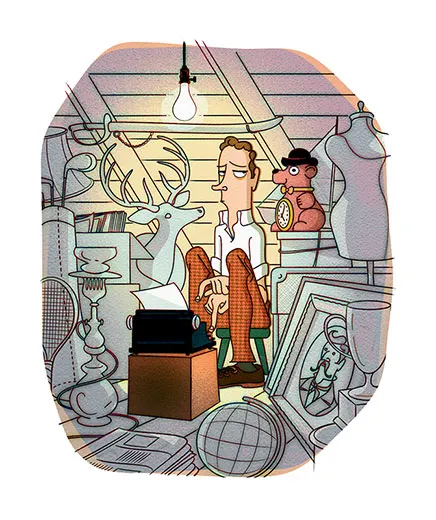The Hoarding Instinct
Dispatches From My War on Stuff
We have a rule in my house that for every box of stuff stashed in the attic, at least one must be removed. The reality is that it would take 6—or maybe 27—boxes to make a dent in the existing inventory. But this creates a conflict with another rule against adding to the local landfill. So, for a while, I was taking things out of the attic and, for the good of the earth, hiding them in closets and under beds.
Then my grown children sat me down and said, “We love you, but...” I know how interventions work. I put on a glum face and confessed, “My name is Dad, and I am a hoarder.” And with these words, I manfully enlisted in the War on Stuff.
We are all foot soldiers in this war, though mostly AWOL. Surveys say that 73 percent of all Americans enter their houses via the garage—each of them staring straight ahead to avoid seeing the stuff piled up where the cars are supposed to go. The other 27 percent never open the garage door, for fear of being crushed beneath what might come tumbling out.
It’s mostly stuff we don’t want. The treasures in my attic, for instance, include a lost Michelangelo. Unfortunately, that’s the character name of a Teenage Mutant Ninja Turtle action figure my son misplaced when he was 8. There’s also a yearbook from a school that none of us attended and a photograph of a handsome Victorian family, who are either beloved ancestors or total strangers who happened to be in a pretty picture frame we once bought. Two barrels ostensibly contain precious family heirlooms. I suspect that, if ever opened, they will turn out like Al Capone’s vault and contain nothing more than vintage dust.
My opening salvo in the War on Stuff was not, in truth, all that manful: It was a covert mission to slip my college hookah in among the merchandise at the neighbor’s garage sale. Then I tried flinging excess dog toys over a hedge into a doggy-looking yard down the street (my dog is a hoarder, too). That went well, until I hit a small child in the head. Next I tried selling an old golf putter on eBay, but after seven days eagerly waiting for my little auction to flare up into a bidding war, I came away with $12.33.
Then I discovered a web service called Freecycle, and my life was transformed. Like eBay or Craigslist, Freecycle is a virtual marketplace for anything you want to get rid of, but all merchandise is free. This four-letter word seems to unleash an acquisitive madness in people who otherwise regard garage sale goods with delicately wrinkled noses. Suddenly strangers were hot-stepping up the driveway to haul away bags of orphaned electrical adapters, a half bag of kitty litter my cats had disdained and the mounted head of a deer (somewhat mangy).
At first, I experienced twinges of donor’s remorse, not because I wanted my stuff back, but because I felt guilty about having suckered some poor souls into taking it. But others clearly had no such qualms. One day my regular Freecycle e-mail came in touting an offer of pachysandra plants, “all you can dig.” Another day it was “Chicken innards & freezer-burnt meat.” And both offers found takers.
I soon came to accept that there is a home for every object—except for the construction paper Thanksgiving turkey I glued together in fourth grade, with the head on backward.
I’m adding that to a new barrel of family heirlooms that I will give my children when they buy their first homes.
Richard Conniff wrote about nation branding in the September 2011 issue of Smithsonian.
/https://tf-cmsv2-smithsonianmag-media.s3.amazonaws.com/accounts/headshot/richard-conniff-240.jpg)

/https://tf-cmsv2-smithsonianmag-media.s3.amazonaws.com/accounts/headshot/richard-conniff-240.jpg)